President's Message
Two of the most significant archaeological finds in North America represent very different cultures. Both have a connection with the history of Henrico County.
The first was the discovery of the original fort of the English settlement of Jamestown by a team led by Dr. William Kelso.
Only days after establishing the first permanent English settlement in America at Jamestown in 1607, Captain Christopher Newport and a crew of twenty-two men, including Captain John Smith, Capt. Gabriel Archer, and George Percey, Esq., explored by shallop, the river they named for King James I of England. Upriver they noted "an ilet on which were many turkeys and greate store of young byrdes like blackbirdes" to be named Turkey Island. They erected a cross inscribed "Iacobus, Rex, 1607, Christopher Newport" near the falls of the James River, an area that would later become Henrico territory.
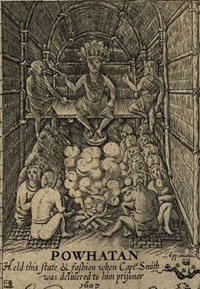
The second discovery (which predates the Jamestown settlement) was the site of Werowocomoco, headquarters of Paramount Chief Powhatan at the time of the English arrival. The Arrohateck Indians encountered John Smith and his party soon after their arrival, along the James River north of the Appomattox. One colonist noted, "they live commonly by the waterside in little cottages made of canes and reeds, covered with the bark of trees. They dwell, as I guess, by families of kindred and allayance...They live upon sodden wheat, beanes, and pease, for the most part, also they kill deare, take fish in their weares and kill fowl aboundance." Interestingly, Chief Powhatan is reported to have been born at the present location of Tree Hill Farm in Henrico County.
Initially, the colonists exchanged trade goods for land; but as the English population increased and their settlements expanded, relations between Indians and settlers grew hostile. Planned attacks were carried out by both sides, and most Indian people were eventually forced to move or were assimilated.
Although the relationship with the native people was at times helpful and at other times hostile, without assistance from American Indians, the English settlements would not likely have survived. The Indian people introduced the colonists to native food sources, without which there would have been a very real threat of starvation.
Many holiday traditions today came from the association with native Indians, which included the abundance of wild turkey and the growing of corn. Also native to America, pumpkins were a valuable food source. The native Indians used every bit of the pumpkin plant - seeds, flesh, flowers, and leaves. Colonists are credited with cooking the pumpkin whole, by cutting off the pumpkin top and cleaning out the seeds filling the inside with milk, spices, and honey. After putting the top back on, the pumpkin was buried in the ashes (as was the custom of native Indians). When done the blackened pumpkin was lifted up and the custard-like contents were scooped out with the cooked insides - an example of the first pumpkin pie.
We are very excited about our speaker for the December 7th meeting. Dr. E. Randolph Turner, III will share with us his most remarkable discovery of the settlement of Werowocomoco.
Please bring a friend. Visitors are always welcome.
Sarah Pace
President
>Back to Top<
It's Dues Renewal Time
We won't be mailing out notices. Memberships may be purchased online at www.henricohistoricalsociety.org/membership.payment.html or by mail. If by mail, please indicate your name and address and which membership type/amount you are renewing; your note and check, made payable to Henrio County Historical Society, can be mailed to: Henrico County Historical Society, P.O. Box 90775, Henrico VA 23273-0075.
One year membership dues are: Individual/$15; Family/$20; Student or Child/$5; Supporting/$25; Sustaining/$50; Corporate/$100; or Benefactor/$3. Or you may purchase a one-time Lifetime membership for $500.
Memberships make a great holiday gift! Add the name and address of the recipient, and we will acknowledge the gift with a card, and he or she will be added to our subscription list.
Thank you for your membership and being a part of Henrico County Historical Society!
>Back to Top<
September HCHS Meeting: Sunday in the Park with John
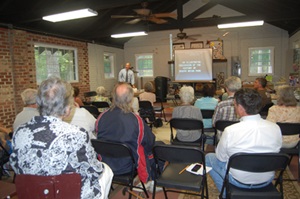
Friends of Bryan Park President John Zeugner addresses the attendants at the September meeting held in the Nature Center at Bryan Park. He spoke about the history of the park and his organization's restoration efforts at the park.
>Back to Top<
The Henrico Historical Society's 2015 Calendar - A Great Gift for the Holidays
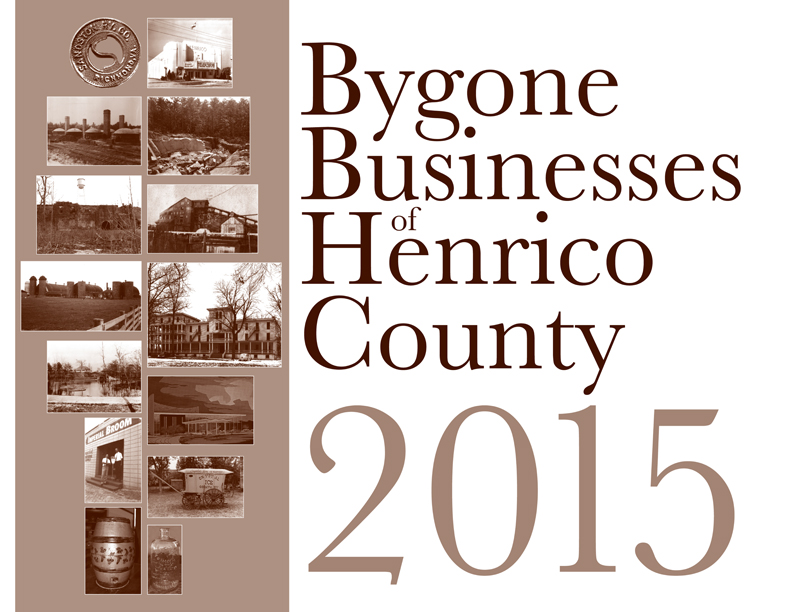
For 2015, we have assembled a 12-part collection of business, industries, and institutions once situated in Henrico County, including quarries, dairies, entertainment, water & ice, potteries, mines, inns & hotels, brickworks, broom manufacturing, and railways.
The cost is $12 plus $5.64 to cover sales tax and shipping & handling. For orders of 5 copies or more, it is $9 and %.53 tax.
Order yours at http://www.henricohistoricalsociety.org/shopping.html (Paypal accepted or send payment to Henrico County Historical Society, P.O. Box 90775, Henrico VA 23273.
>Back to Top<
Lakeside Wheel Club was Lewis Ginter's Country Getaway for ... "Big Wheels" in 1890s Henrico
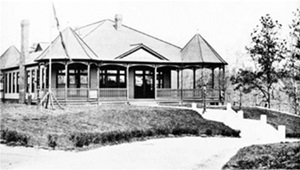
The right-sided image is the former Lakeside Wheel Club: The one-story structure housed Lewis Ginter's club, later became a convalescent center for sick children from the city and today is incorporated into the Bloemendaal House.
On November 24, 1901, the Times of Richmond announced in a headline, "The Decline of the Wheel was Rapid and Complete," and opened the piece by saying, "Nothing that has taken place recently more strikingly exemplifies the similarity of humans to sheep than the decline and fall, not of the Roman Empire, but of the bicycle fad." Implying that the fall of Rome was a recent event was not the only error in the newspaper's account; its assessment that the place of the bicycle fad was "Buried in deepest oblivion in the vast abysm of time" was both bombastic and woefully inaccurate.
Over a century after the bicycle's obituary was written, the "fad" survives and thrives. The Capital Trail project is underway, linking Williamsburg and Richmond with a bike path paralleling Route 5. And in September 2015, the nine-day World Road Cycling Championships (Worlds), one of cycling's pinnacle events, comes to Richmond and anticipates a huge attendance of tourists and a global media audience of 300 million or more.
That trail and those races, though much more impressive in scale, hark back to their ancestors from the early days of bicycling in Henrico County and the Lakeside Wheel Club.
Lakeside in Henrico takes its name from a lake created when a creek was dammed at the site of an old mill pond; and it was here that Major Lewis Ginter established the Lakeside Wheel Club, a social or "country" club, a countryside getaway for Richmonders who enjoyed bicycling. Members of Richmond's Commonwealth Club and Westmoreland Club formed the wheel club, and on Monday, November 4, 1895, they held their formal opening. The Richmond Dispatch of the following day noted that it was "celebrated by an elegant banquet" and that "Quite a large proportion of the membership went out to the club-house on their wheels about 5 o'clock." Members roamed the grounds, had a "spirited game" in the facility's bowling alley and spent time in the smoking room.
The park quickly became a streetcar destination as well as a destination for bicycling and outdoor excursions. A bike trail featured packed cinders and ran from Broad Street to Hermitage Road, parallel to the Boulevard, and eventually became known as Lakeside Avenue. The entire park eventually included boat houses, the region's first golf course, a casino, pavilion, restaurant and a zoological garden.
The club-house was an impressive structure, which the Richmond Dispatch of October 20, 1895, described before its opening as having "a smoking-room, drawing-room buffet and ladies' rooms, and with a spacious hall running the whole length of the house...with its large Dutch fireplace and high-pitched ceiling." While the club-house did have ladies' rooms, women were not admitted as members; instead, as the article stated, "the institution should not only be for its members, but as well for their lady friends, to whom will be issued cards of invitation, extending to them the privileges of the club-house and the grounds".
One of those privileges would have been attendance at awards ceremonies and dancing held after wheel club sponsored races. And these races were an interesting lot of competitions, with the ladies participating in a non-racing capacity in some of them. These events were called Gymkhana races, a term that seems to have originally applied to equestrian events in which a day of races demanded riders and horses to display a range of skills and aptitudes. However, in these bicycle Gymkhanas some of the skills and aptitudes were a bit curious. The events of the Lakeside Races of Saturday, May 29, 1898, as described in the following days' Richmond Dispatch and Times, bear witness to this.
One event was a thread-needle race, where the riders made a hundred-yard dash, dismounted and presented a needle to a young lady. She would thread the needle, and he would return to the bicycle, or wheel as it was called by the wheelmen, and return to the starting spot. Mr. Horace Hawes, whose needle was threaded by Miss Mabel Walker, took first place, earning a "bachelor's repair kit" - presumably, a small portable sewing kit.
In the ginger-ale race, wheelmen road a hundred yards, dismounted, drank a bottle of ginger ale, then remounted and returned to the starting point. The Richmond Dispatch reported that several contestants could not finish their bottles and, therefore, did not finish the race. First-place finisher Llewellyn McVey won a corkscrew.
Mr. McVey was back for the umbrella race, finishing first and winning a cyclometer. His victorious feat involved riding one-hundred yards, raising his umbrella and returning with it over his head. He also got to keep the umbrella, which race organizers required to be at least 26 inches in diameter.
These "Joshes," as the Times called them, were sandwiched between more standard competitions. A half-mile scratch race required contestants to all start from the same point; and first, second, and third places took a gold pin and club colors, a club sweater, and a tachometer, respectively. A one-mile dash for the club championship earned Mr. Albert Tanner a silver trophy, while the last event was a four-mile handicap race among the entrants in the first race. Tanner won this one as well in just a little over twelve minutes and won a set of racing tires. Second place earned a bicycle saddle, and the third place finisher took home a belt.
Competition in these events was limited to the Lakeside Wheel Club membership, and the course, according to the Richmond Dispatch, was "laid off on the road running from the Hermitage road to the Brook pike, between Westbrook and Bellevue."
Such events made the Lakeside Wheel Club quite the fashionable meeting place for Richmond elites. And in commenting on "another of their delightful Saturday afternoon meets," the Richmond Dispatch on April 11, 1897, said, "Since the inauguration here of the Saturday half-holiday in recent years, no one thing has contributed more healthful pleasure than the Lakeside Wheel club." The paper also noted that at a banquet at the Commonwealth Club, "Many toasts were responded to, but none more heartily than the toast: 'Long live the Lakeside Wheel Club.'"
However, the wheel club did not live long. It lasted past founder Lewis Ginter's death in 1897; but it was later abandoned, bought by Ginter's niece, Grace Arents, who remodeled it and made it a convalescent home for sick children from the city, and finally incorporated into the Bloemendaal House. So when the international "wheelmen" roll into Richmond in 2015 for the World Road Cycling Championships, we should all pause to recall the early days of the wheel in Henrico County at the Lakeside Wheel Club.
Joey Boehling

Southern appeal: In an advertisement from the May 10, 1896 Richmond Displatch, E. B. Taylor promotes a line of bicycles commemorating Robert E. Lee. The "wheels" were made locally by J. E. Stonebraker & Brothers at 218 North Third Street.

Popular wheels: While this 1880s photograph of the Executive Mansion shows early cycling enthusiasts riding high-wheel bicycles unlike those raced at the Lakeside Wheel Club, it does indicate the popularity of the machines.
>Back to Top<
Female Fashion for the Wheeling Set
The fashionable wheelwoman of the 1890s was decked out from head to toe in bicycle-related attire. To get an idea of the style, let's start at the top with Kaufmann & company's ad for its store at the corner of 4th and Broad Streets in the Richmond Times of July 26, 1896. Referring to its ladies' bicycle hats, Kaufman claimed, "We show the regular English stitched alpine or bicycle Hat in Grass, Linen, Crash, Wool, Felt, Velvet, Brilliantine, and in cotton material to match suits from 48c. to $1.38. No lady who rides a bicycle ought to be without one, being comfortable, becoming, and low in price to meet the times."
And ladies who road bicycles were lauded in a Richmond Times article headlined "The Easter Girl of 1897." A section with the heading "Easter Bloomers" said, "But the girl who enjoys herself most in the outdoor sports of this spring is certainly the bicycle girl." It went on to note a curious comment on the attire of the day that "Now, that the ban is removed from the wearing of bloomers, she can put on the little checkered trousers, jump on the wheel and ride until every nerve tingles and her cheeks are red with fun."
Bicycle-riding ladies also spored outfits known as bicycle suits. Richmond's Saks' store ran an ad occupying a half of page 19 in the March 28, 1897 Richmond Dispatch, two thirds of which was taken up with bicycling paraphernalia, indicating the popularity of the activity. Saks' offered three ladies bicycle suits. Their $4.99 five-piece consisted of a "Hat, coat, Skirt, Bloomers, and Leggins, made up in a special Covert-live weave." Its Eton style jacket was to be work with silk or wash waist. At $5.50, ladies could purchase "the very best wool Bicycle Suit in town for the money." This three-piece suit was navy blue and consisted of "Jacket, Skirt, and Leggins." And lastly, the "$16 Brown Scotch Mixed Homespun bicycle Suit with Eton Jacket Hat, Skirt, Bloomers, and Leggins, handsomely trimmed with leather and buttons" was on sale for twelve dollars.
But perhaps the most interesting costume to arise from the bicycling trend, oddly enough grew out of the works of Williams Shakespeare. According to the Richmond Dispatch of December 12, 1897, London author Madame Sarah Grand, "Madame Grand is an enthusiastic admirer of Shakespeare, and the more she studied the free and easy grace of Rosalind [from As You Like It], of the russet doublet and hose, the more she became convinced that had bicycles been in use during the Shakesperian [sic], the doublet and hose would have been the costume that level-headed women would have adopted." For her outfit, she "discarded all the nineteenth-century articles of dress that fettered the sex when a-wheeling." The suit was for winter wear and was made of the white fur. It had a "natty cloak of the rosalind era" and tight-fitting knickerbockers. The paper noted that "It is such a startlingly long step, even from the bloomer costume, that most women will probably be a little shy about appearing in public until bolder skirts have take the rough edge of the sensation such a costume will cause." Madame Grand dubbed her creation her "Christmas bicycle costume," and claimed that "she has given additional cause for rejoicing among women during the coming holiday season."
Joey Boehling
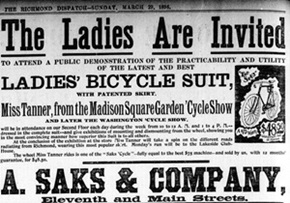


Styles for wheelwomen.
(Top left) A Richmond Dispatch advertisement makes it appeal to feminine riders
(Top right) An 1890s illustration depicts the demure bicycling fashion of the time.
(Left) Madame Grand's "Christmas bicycling costume" in white fur.
>Back to Top<
Now You Know: The "Weighty" Matter of Time
The object from the last "What Do You Know?" powered early clocks.
We're sorry to say that nobody "took the time" to identify the last issue's "What Do You Know?" object as a clock weight, a heavy metal object that provided the power for many early pendulum clocks.

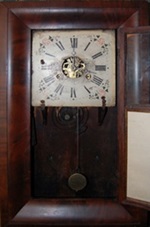
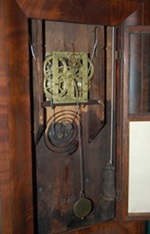
Above is an ogee clock, so named because of the curved molding framing the glass door that gives access to the clock's works and allows for winding.
A key is inserted into the small holes just above the VII and IIII and turned, thereby raising the corresponding weight to the top of the case and essentially allowing gravity to drive the clock.
As the weight on the right descends, its string causes the gear of the clock's works to turn, with the interaction of the escapement in the center and the pendulum regulating the rate. That weight is responsible for turning the hour and minute hands.
Weight on the left powers the chime. As the minute reaches the XII, the weight's descent causes the small round hammer to strike the coil and sound the appropriate number of notes. Upon reaching the VI, the minute hand triggers the weight's descent for a single strike.
This particular clock is a thirty-hour clock, meaning that it requires winding on a daily basis.
Question: Why is the Roman numeral IIII for four used on a clock instead of the standard IV? Let us know if you have the answer.
>Back to Top<
What Do You Know?
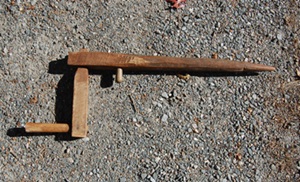
The hand-made wooden item pictured at the right is 35 inches long from the tip of the handle to the point at the end. A two-inch wooden knob projects from a point four inches below the handle.
Do you know what it is?
Email your answers to jboehling@verizon.net.
>Back to Top<
News 2014: Fourth Quarter
First Quarter | Second Quarter | Third Quarter
Home | Henrico | Maps | Genealogy | Preservation | Membership | Shopping | HCHS
|











